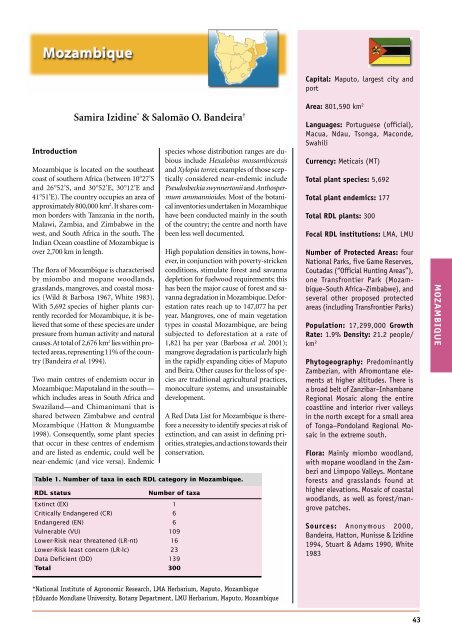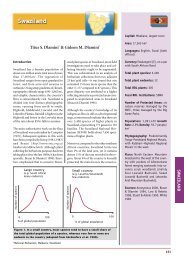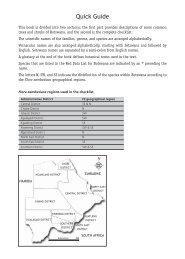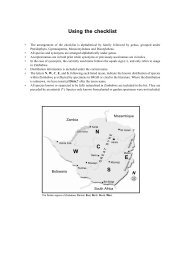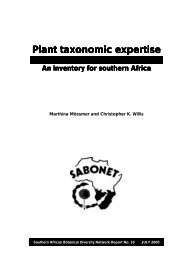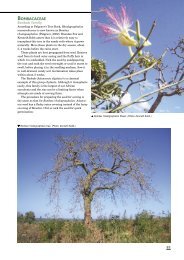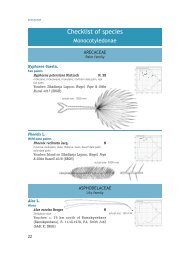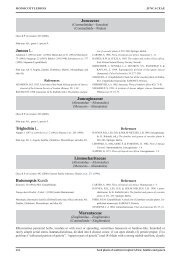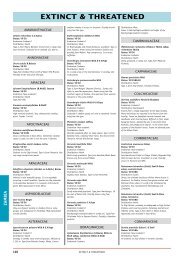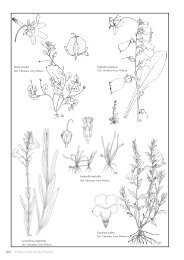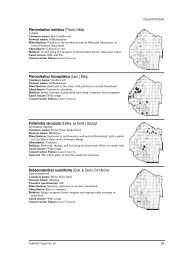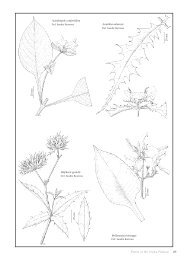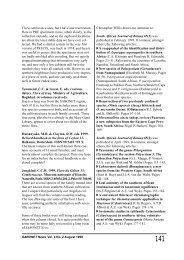Samira Izidine* & Salomão O. Bandeira† - SABONET
Samira Izidine* & Salomão O. Bandeira† - SABONET
Samira Izidine* & Salomão O. Bandeira† - SABONET
Create successful ePaper yourself
Turn your PDF publications into a flip-book with our unique Google optimized e-Paper software.
MOZAMBIQUE<br />
Introduction<br />
<strong>Samira</strong> Izidine * & <strong>Salomão</strong> O. Bandeira †<br />
Mozambique is located on the southeast<br />
coast of southern Africa (between 10°27’S<br />
and 26°52’S, and 30°52’E, 30°12’E and<br />
41°51’E). The country occupies an area of<br />
approximately 800,000 km 2 . It shares common<br />
borders with Tanzania in the north,<br />
Malawi, Zambia, and Zimbabwe in the<br />
west, and South Africa in the south. The<br />
Indian Ocean coastline of Mozambique is<br />
over 2,700 km in length.<br />
The flora of Mozambique is characterised<br />
by miombo and mopane woodlands,<br />
grasslands, mangroves, and coastal mosaics<br />
(Wild & Barbosa 1967, White 1983).<br />
With 5,692 species of higher plants currently<br />
recorded for Mozambique, it is believed<br />
that some of these species are under<br />
pressure from human activity and natural<br />
causes. At total of 2,676 km 2 lies within protected<br />
areas, representing 11% of the country<br />
(Bandeira et al. 1994).<br />
Two main centres of endemism occur in<br />
Mozambique: Maputaland in the south—<br />
which includes areas in South Africa and<br />
Swaziland—and Chimanimani that is<br />
shared between Zimbabwe and central<br />
Mozambique (Hatton & Munguambe<br />
1998). Consequently, some plant species<br />
that occur in these centres of endemism<br />
and are listed as endemic, could well be<br />
near-endemic (and vice versa). Endemic<br />
species whose distribution ranges are dubious<br />
include Hexalobus mossambicensis<br />
and Xylopia torrei; examples of those sceptically<br />
considered near-endemic include<br />
Pseudosbeckia swynnertonii and Anthospermum<br />
ammannioides. Most of the botanical<br />
inventories undertaken in Mozambique<br />
have been conducted mainly in the south<br />
of the country; the centre and north have<br />
been less well documented.<br />
High population densities in towns, however,<br />
in conjunction with poverty-stricken<br />
conditions, stimulate forest and savanna<br />
depletion for fuelwood requirements; this<br />
has been the major cause of forest and savanna<br />
degradation in Mozambique. Deforestation<br />
rates reach up to 147,077 ha per<br />
year. Mangroves, one of main vegetation<br />
types in coastal Mozambique, are being<br />
subjected to deforestation at a rate of<br />
1,821 ha per year (Barbosa et al. 2001);<br />
mangrove degradation is particularly high<br />
in the rapidly expanding cities of Maputo<br />
and Beira. Other causes for the loss of species<br />
are traditional agricultural practices,<br />
monoculture systems, and unsustainable<br />
development.<br />
A Red Data List for Mozambique is therefore<br />
a necessity to identify species at risk of<br />
extinction, and can assist in defining priorities,<br />
strategies, and actions towards their<br />
conservation.<br />
Table 1. Number of taxa in each RDL category in Mozambique.<br />
RDL status Number of taxa<br />
Extinct (EX)1<br />
Critically Endangered (CR)6<br />
Endangered (EN)6<br />
Vulnerable (VU)109<br />
Lower-Risk near threatened (LR-nt)16<br />
Lower-Risk least concern (LR-lc)23<br />
Data Deficient (DD)139<br />
Total 300<br />
*National Institute of Agronomic Research, LMA Herbarium, Maputo, Mozambique<br />
†Eduardo Mondlane University, Botany Department, LMU Herbarium, Maputo, Mozambique<br />
Capital: Maputo, largest city and<br />
port<br />
Area: 801,590 km 2<br />
Languages: Portuguese (official),<br />
Macua, Ndau, Tsonga, Maconde,<br />
Swahili<br />
Currency: Meticais (MT)<br />
Total plant species: 5,692<br />
Total plant endemics: 177<br />
Total RDL plants: 300<br />
Focal RDL institutions: LMA, LMU<br />
Number of Protected Areas: four<br />
National Parks, five Game Reserves,<br />
Coutadas (“Official Hunting Areas”),<br />
one Transfrontier Park (Mozambique–South<br />
Africa–Zimbabwe), and<br />
several other proposed protected<br />
areas (including Transfrontier Parks)<br />
Population: 17,299,000 Growth<br />
Rate: 1.9% Density: 21.2 people/<br />
km 2<br />
Phytogeography: Predominantly<br />
Zambezian, with Afromontane elements<br />
at higher altitudes. There is<br />
a broad belt of Zanzibar–Inhambane<br />
Regional Mosaic along the entire<br />
coastline and interior river valleys<br />
in the north except for a small area<br />
of Tonga–Pondoland Regional Mosaic<br />
in the extreme south.<br />
Flora: Mainly miombo woodland,<br />
with mopane woodland in the Zambezi<br />
and Limpopo Valleys. Montane<br />
forests and grasslands found at<br />
higher elevations. Mosaic of coastal<br />
woodlands, as well as forest/mangrove<br />
patches.<br />
Sources: Anonymous 2000,<br />
Bandeira, Hatton, Munisse & Izidine<br />
1994, Stuart & Adams 1990, White<br />
1983<br />
43<br />
MOZAMBIQUE
MOZAMBIQUE<br />
Table 2. Families containing the<br />
highest numbers of RDL species.<br />
Family Number of species<br />
Rubiaceae 26<br />
Fabaceae 20<br />
Euphorbiaceae 15<br />
Zamiaceae 13<br />
Table 3. Endemism on the RDL for<br />
Mozambique.<br />
Endemism Number<br />
of taxa<br />
Confirmed endemic 166<br />
Suspected endemic 11<br />
Confirmed near-endemic 60<br />
Suspected near-endemic 17<br />
Total 254<br />
Methods<br />
Information Synthesis<br />
During the first phase of RDL compilation,<br />
information regarding threatened plant<br />
species or those potentially at risk of extinction<br />
was synthesised. Data were gleaned<br />
from lists by Bandeira et al. (1994), Van<br />
Wyk (1996), Hatton & Munguambe<br />
(1998), Oldfield et al. (1998), and Walter &<br />
Gillett (1998). These lists tended to concentrate<br />
on endemic, medicinal, and woody<br />
species.<br />
After the compilation of the draft list, a Red<br />
Data List workshop was held in Maputo<br />
from 23 to 27 October 2000. Participants<br />
were trained in the use of the IUCN criteria<br />
and categories (IUCN 1994). Flora de<br />
Moçambique and Flora Zambeziaca were<br />
used to refine the preliminary list of species<br />
that merited Red List status. Additional<br />
information on some of the better known<br />
plant species from southern Mozambique<br />
was obtained from field observations by<br />
botanists. Herbarium specimen information<br />
from LMA and LMU was used to identify<br />
additional species localities, but was<br />
subsequently found to be of extremely limited<br />
value. Vegetation maps were used to<br />
determine the distribution of habitats in<br />
which the Red Listed species occur and<br />
were also used to estimate threats.<br />
We attempted to estimate distribution<br />
ranges (Extent of Occurrence and Area of<br />
Occupancy) but data were so unreliable<br />
(taxonomically), sparse, and outdated, and<br />
revealed so little about the threats in the<br />
habitats of many species, that it became<br />
extremely difficult to make assumptions<br />
and inferences.<br />
44<br />
Red List evaluations were done for species<br />
falling into the following categories:<br />
• Species endemic or near-endemic to<br />
Mozambique<br />
• Species restricted to small areas or limited<br />
habitats<br />
• Utilised taxa (timber, medicinal, and<br />
ornamental purposes)<br />
• Taxa in close proximity to high impact<br />
areas (settlement areas, agricultural and<br />
industrial developments)<br />
Application of the Red Data List<br />
Categories<br />
The IUCN (1994) Red List categories and<br />
criteria were applied, based on evidence<br />
concerning numbers, trends in disappearance,<br />
and the distribution of taxa. Factors<br />
such as population pressure on a species,<br />
proximity to human settlements, and agricultural<br />
and industrial activities were taken<br />
into consideration. For example, if a species<br />
occurs near human settlements or agricultural<br />
and industrial activities, then it<br />
is more likely to be lost.<br />
The Vulnerable D2 category was applied<br />
judiciously in cases where species were<br />
found only in type localities, the distribution<br />
range was likely to be narrow, and if<br />
threats were known. The Data Deficient category<br />
was applied in cases where species<br />
were known only from the type collection<br />
or from a single locality and where no information<br />
regarding threats was available.<br />
The threatened categories (Critically Endangered,<br />
Endangered and Vulnerable) were<br />
applied when the risk of extinction was<br />
certain and known to be high. Only in a<br />
few exceptional cases—for example, Raphia<br />
australis and the 13 Encephalartos species<br />
recorded for Mozambique—was complete<br />
information available, that is, throughout<br />
the entire distribution range for the species<br />
concerned.<br />
Results and Discussion<br />
Red Data List<br />
Some species found in the RDL presented<br />
here occur in previous, very prominent<br />
publications; the World List of Threatened<br />
Trees (Oldfield et al. 1998) listed 78 species<br />
and the 1997 IUCN Red List of Threatened<br />
Plants (Walter & Gillett 1998) listed 89 vascular<br />
plants (including trees) for Mozambique.<br />
In addition, several near-endemic<br />
species that occur in Mozambique were<br />
listed in Hilton-Taylor (1996) in the RDLs<br />
for Swaziland (Lebombo Mountains) and<br />
South Africa (Maputaland).<br />
Some 300 species, by contrast, are listed in<br />
the list presented here. Of these, 122 are<br />
listed as Critically Endangered (CR), Endangered<br />
(EN), and Vulnerable (VU). Many<br />
species (139) have, however, been categorised<br />
as Data Deficient (DD). Virtually all<br />
of the DD species are known from only one<br />
or a few herbarium collections, with very<br />
sparse and irrelevant information on the<br />
specimen labels. Many species, moreover,<br />
are not properly identified or possess uncertain<br />
taxonomic identification.<br />
In addition, the fact that few inventories<br />
were compiled for the interior and north<br />
of Mozambique, led to a far higher representation<br />
of southerly distributed plants on<br />
the Red Data List.<br />
Certain plant species like Dombeya cymosa,<br />
Carpodiptera africana, Corchorus junodii,<br />
and Grewia glandulosa, which were represented<br />
in previous Red Data Lists, have<br />
been excluded from this List. This is partially<br />
because the IUCN (1994) categories<br />
take into account quantitative data and exclude<br />
these species as candidates for a Red Data<br />
List owing to their abundance in the wild.<br />
With regard to plant families on the Red<br />
Data List, the Rubiaceae, Fabaceae<br />
(Leguminosae), and Euphorbiaceae are<br />
well-represented compared to other families<br />
(Table 2); this was an expected result,<br />
as these families are well-studied. The<br />
Orchidaceae of Mozambique, on the other<br />
hand, have been relatively poorly studied<br />
and are poorly represented because of a lack<br />
of field information. For example, Eulophia<br />
biloba is known only from a single specimen<br />
that was collected in 1895 near Beira,<br />
which today is a large coastal town. There<br />
are several similar examples from the<br />
Orchidaceae: Eulophia bissacata, Disperis<br />
mozambicense, Habenaria mossambicensis,<br />
and Liparis hemipiloides. Similarly, little is<br />
understood about the Poaceae of Mozambique,<br />
as many species are known only<br />
from a specific location; this may be an artefact<br />
resulting from the general unpopularity<br />
of collecting grasses. Furthermore,<br />
many grasses particularly from the coastal<br />
areas, may have been introduced from<br />
other countries—the Mozambique coastline<br />
has hundreds of years of trade history<br />
with neighbouring countries on the African<br />
mainland and the surrounding islands.<br />
Some 177 endemic species appear on the<br />
List (Table 3)—these endemics are found<br />
mainly in the Maputaland zone and the<br />
Chimanimanis. Some taxa have been listed<br />
as near-endemic (77 species), as they are
also found in South Africa, Swaziland, Tanzania,<br />
and Zimbabwe. It is, however, suspected<br />
that Mozambique possesses many<br />
more range-restricted species, especially in<br />
the north of the country. More inventories<br />
and field explorations are recommended<br />
in the northern countryside, as many species<br />
are likely to be shared across the<br />
Rovuma River and other political boundaries<br />
with Tanzania, presenting opportunities<br />
for collaborative field research.<br />
Useful and Threatened Species<br />
As in most other southern African countries,<br />
timber, medicinal, edible, and ornamental<br />
species are the most important<br />
groups of plant used in Mozambique. Close<br />
to 70% of the Mozambican population uses<br />
medicinal plants for basic healthcare<br />
(World Conservation Monitoring Centre<br />
1992); urban markets in Maputo and Beira<br />
sell medicinal plants derived from many<br />
parts of the country.<br />
In general, all utilised plants should be<br />
monitored, as they may be eligible for Red<br />
Lists, and their depletion will undoubtedly<br />
have serious socio-economic consequences.<br />
Timber species that were included<br />
in this List, such as Milicia excelsa (LR-nt)<br />
and Afzelia quanzensis (LR-nt), should be<br />
monitored. Medicinal plants such as<br />
Warburgia salutaris (VU A2cd), used for<br />
alleviating throat complaints (Bandeira et<br />
al., in press), should also be monitored.<br />
Species of Encephalartos are believed to be<br />
illegally exported for use as ornamental<br />
plants, mainly to neighbouring countries.<br />
The major threats to plant species in Mozambique<br />
are related to uses of a non-sustainable<br />
nature and include:<br />
• Heavy exploitation of natural resources<br />
for fuelwood<br />
• Industrial development<br />
• Traditional agricultural practices<br />
• Human settlements and urbanisation<br />
The most sensitive ecosystem zones include<br />
coastal areas and the areas surrounding<br />
main towns, owing to high population densities.<br />
In poverty-stricken areas, the main<br />
threat is deforestation for fuelwood and<br />
charcoal. Commercial deforestation takes<br />
place mainly in south-central Mozambique<br />
and in mangrove areas where there is a high<br />
abundance of woody tree species whereas<br />
industrial development and urbanisation<br />
are very high in Maputo and Sofala Provinces.<br />
In addition, destructive agricultural<br />
practices take place on a large scale, mainly<br />
in rural areas.<br />
Inhamitanga Forest in pristine condition. (Photo: J. Burrows)<br />
Inhamitanga Forest—the trail of destruction. (Photo: J. Burrows)<br />
Conclusions and<br />
Recommendations<br />
While compiling this List, several constraints<br />
were encountered: these range from<br />
a lack of information to the lack of a national<br />
checklist and incomplete and outdated<br />
information. We found that herbarium<br />
specimen information is an inadequate<br />
basis for determining Red Data List<br />
status for the plant species of Mozambique.<br />
Our knowledge of the flora of Mozambique<br />
is mostly restricted to southern Mozambique<br />
and field exploration in northern and<br />
central Mozambique is needed to update<br />
scientific information, as well as to increase<br />
the numbers of herbarium collections.<br />
Gathering information on endemics and<br />
near-endemics is especially important.<br />
Collaboration with neighbouring countries<br />
(Malawi, South Africa, Swaziland, Tanzania,<br />
and Zimbabwe) and sharing of expertise<br />
are important elements that can assist<br />
in the compilation of botanical inventories.<br />
These inventories will form a basis for directly<br />
assisting in national conservation<br />
planning, sustainable resource utilisation<br />
strategies, and further research priorities.<br />
Acknowledgements We would like to express<br />
our sincere gratitude to the Red Data List National<br />
Working Group: Filomena Barbosa,<br />
Angelina Martins, Ana Bela Amude, Carla<br />
Ruas, Eduardo Massingue, Felisbela Gaspar,<br />
Silva Mulhovo, Köeti Seródio, Catarina<br />
Chidiamassamba, Maria da Luz Dai, and<br />
Agostinho Lisboa. Our thanks are extended<br />
to Janice Golding and Peter Phillipson who<br />
compiled and edited the Red Data List assessments.<br />
Marta Monjane and Paul Dutton,<br />
staff of Kew Herbarium (K), and anyone who<br />
directly or indirectly contributed to this work<br />
are also thanked.<br />
45<br />
MOZAMBIQUE


